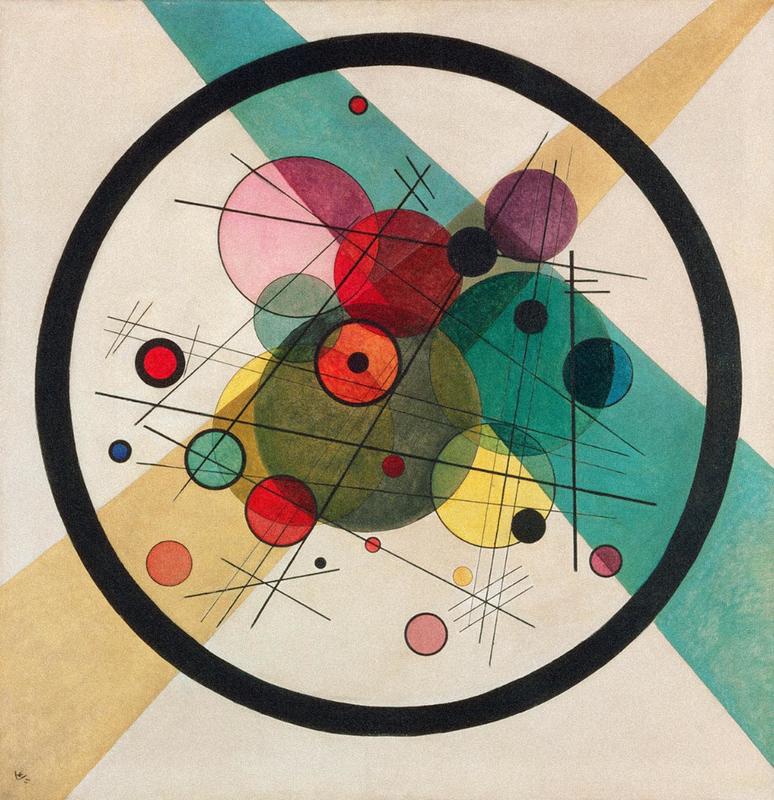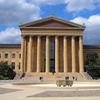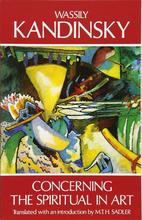More about Circles in a Circle
- All
- Info
- Shop

Contributor
In 1923, Wassily Kandinsky painted Circles in a Circle.
Though this title is rather obvious, his composition, and the symbolism embodied in the work, is not. Kandinsky described the piece as being "the first picture of mine to bring the theme of circles to the foreground." Marcel Duchamp described Kandinsky’s work as “open[ing] to the spectator a new way of looking at painting . . . a clear transfer of thought on canvas.”
At first brush, these descriptions cast a rather cult-y impression over the work. The more you dig in to the painting and its creator, the more this impression seems valid. Kandinsky is thought to have had synesthesia. For him this manifested in the interaction of sight and sound: he associated shapes and colors with musical notes and rhythms (as represented in his painting Composition 8). He is also known to have been a very philosophical man and artist: he often explored the balance of the cosmos and of the concept of spirituality through his work. Though Kandinsky painted many circular forms, he used the shape of a triangle to embody his idea of humanity’s spiritual enlightenment and ascent. Though the Illuminati officially disbanded more than 100 years earlier (or so they say), it isn’t too much of a stretch to put this man in conversation with the organization that also believed in a tiered ascent to “illumination.”
The colors and lines in Circles in a Circle do give the work a rather dizzying effect. Grounded by the thick black outer circle, the inner components seem to buzz with energy, or act like colorful bubbles boiling to the surface of some mystical pool. The work has an organic influence - something like starlight or sun rays - though also a graphic urgency which certainly comes out of his time teaching at the Bauhaus, where he was from 1922-1933. Other people have taken this complicated composition and analyzed it from a symbolic perspective, digging in to the representations of the colors and the specific number of lines and circles. If that doesn’t scream conspiracy theory, I don’t know what does.
Circles in a Circle now lives at the Philadelphia Museum of Art. To me this seems poetic. The front steps of the PMA are known as the “Rocky Steps,” where Sylvester Stallone famously made his ascent. I love that in order to see this artwork - a piece that explores enlightenment in both form and color - you have to make your own physical ascent, following Kandinsky’s triangle of enlightenment to the shrine of the painting. The artist would no doubt like the added symbolism.
Sources
- “Bauhaus.” The Art Story, accessed 26 May 2019, https://www.theartstory.org/movement-bauhaus.htm.
- Castro, Joseph. “What is the Illuminati?” LiveScience, 30 September 2013, accessed 26 May 2019, https://www.livescience.com/40048-what-is-the-illuminati.html.
- “Circles in a Circle.” Philadelphia Museum of Art, accessed May 26, 2019, https://www.philamuseum.org/collections/permanent/51019.html.
- “Circles in a Circle.” wassilykandinsky.net, accessed 26 May 2019, https://www.wassilykandinsky.net/work-247.php.
- Hernández, Isabel. “Meet the Man Who Started the Illuminati.” National Geographic, accessed May 26, 2019, https://www.nationalgeographic.com/archaeology-and-history/magazine/201….
- “Kandinsky at the Bauhaus, 1922-1933.” Solomon R. Guggenheim Museum, accessed May 26, 2019, https://www.guggenheim.org/exhibition/kandinsky-at-the-bauhaus-1922-1933.
- Lebowitz, Rachel. “How to Be an Artist, According to Wassily Kandinsky.” artsy, 12 June 2017, accessed May 26, 2019, https://www.artsy.net/article/artsy-editorial-artist-kandinsky.
- Mrksic, Paulina. “Vassily Kandinsky - Circles in a Circle.” 2017, accessed 26 May 2019, https://interface.fh-potsdam.de/gestalten-in-code/projects/vassily-kand….
- “The universe, as seen by art and science - in pictures.” The Guardian, 30 September 2017, accessed 26 May 2019, https://www.theguardian.com/science/gallery/2017/sep/30/the-universe-as….
- Travis. “Wassily Kandinsky: Synesthesia and Abstraction.” synesthesiatest.org, July 2012, accessed May 26, 2019, https://www.synesthesiatest.org/blog/wassily-kandinsky-abstraction.














